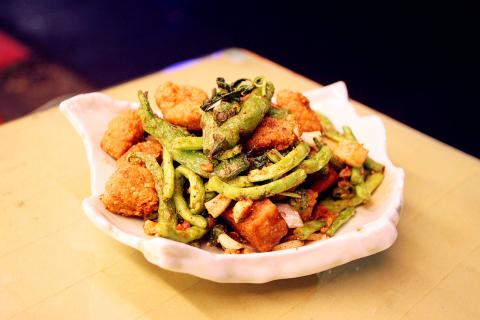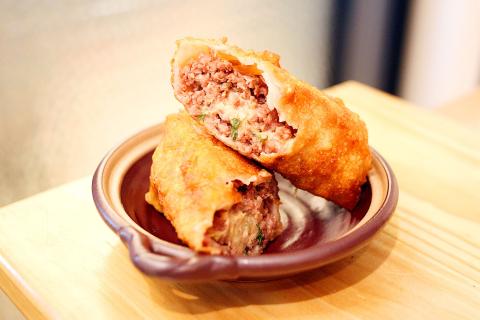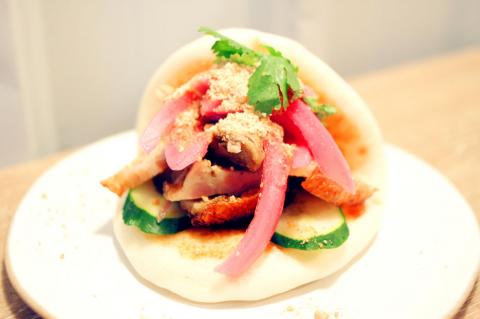In case you needed any proof that Taipei’s food and beverage scene is alive and well, young and independent restaurateurs are continuing to strike out on their own with unconventional takes on local cuisine.
They may not have big backers, but from humble spaces and with concentrated menus, they are reenergizing the Taiwanese table with delicious, youthful irreverence.
CHU ZHA SNACK SHOP

Photo: Davina Tham, Taipei Times
The female duo behind this fry station has unusual pedigree, as street vendors go. Both were previously at Italian restaurant Popina, and that finesse and European influence are apparent — this is no ordinary Taiwanese popcorn chicken (鹹酥雞) stand.
Although “snack shop” (小食) is in the name, I had no trouble culling a full meal from the menu. Staples of the deep-fried genre are plentiful, including popcorn chicken (NT$55), chicken cartilage (NT$55) and skin (NT$30) and silver-stripe round herring (丁香魚, NT$60). Even daily servings of vegetables can be fulfilled with long beans (NT$30) and sweet chili peppers (NT$30).
Unlike many popcorn chicken stands, which tend to disappoint with stringy meat and gluey batter, Chu Zha’s version is succulent and achieves a crust just thin enough to carry the necessary crunch and chili powder. Another mark of thoughtful cooking is that the chicken is seasoned all the way through, rather than falling back on an external dusting of condiments.

Photo: Davina Tham, Taipei Times
And despite the exponential increase in quality, the quantity does not suffer too much — I count 11 pieces in a single order.
Non-meat ingredients are handled with just as much care. Handmade taro cake (NT$30) is smooth, chewy and perfumed with dried shrimp. Oyster mushrooms (NT$30) stay juicy within a crisp exterior. Sweet potato fries (NT$25) are paired with a sprinkling of sour plum powder to accentuate their natural sugars.
A portion of the menu is also dedicated to foods that have first been braised in lu (滷) gravy before being deep-fried — think pig’s trotters (NT$90), five-spice tofu (NT$25) and pig’s intestines stuffed with glutinous rice (NT$30).

Photo: Davina Tham, Taipei Times
Despite my plate being piled high with a mixture of deep-fried morsels, all topped with the same raw garlic, onion and chili powder, each ingredient is cooked perfectly and tastes distinct.
The above are just the basics, which are more than met at this point. But where the chefs’ skill and personality really come through is in the rotating chalkboard specials, which elevate the Taiwanese deep-fry to something quite special.
A fritter of beef mince laced with tuna (NT$90) is Chu Zha’s take on vitello tonnato, a traditional Piedmontese dish of thinly sliced veal and tuna sauce. This may not sound like an intuitive surf-and-turf combination, but it’s a classic for a reason. Briny tuna amplifies the savoriness of the beef, giving it a well-roundedness that eludes even some restaurant entrees.

Photo: Davina Tham, Taipei Times
Shredded duck meat and lotus root (NT$80) cooked in Angelica sinensis (當歸) achieves layered textures in a neat package, as toothsome as it is intriguing. But what every regular asks after are the deep-fried peppers filled with beef mince and Gouda cheese (NT$60), which have a tendency to sell out mid-week. Like a Taiwanese jalapeno popper, these are the perfect accompaniment to a chilled European or South American beer (NT$150).
For the dessert course, a fritter of handmade taro paste with dark chocolate filling (NT$30) is subtly sweet, but is also not as compelling as the savory options.
With just 10 seats, Chu Zha’s shop space is as petite as the two women behind its counter. But there’s an understated aggressiveness to this joint, one that extends from the raging hot oil of the deep fryer, to the creative ambition of its chefs.
Chu Zha Snack Shop
(初炸小食店)
Address: 57, Ln 308, Guangfu S Rd, Taipei City
(台北市光復南路308巷57號)
Telephone: (02) 2776-5855
Open: Sunday to Thursday, 3pm to 11pm; Friday to Saturday, 3pm to midnight
Average meal: NT$180
Details: Menu in Chinese; cash only
On the Net: www.facebook.com/DeepFry2018
MAN BAO
Chifeng Street (赤峰街) in Datong District (大同) houses an intriguing mix of new, design-conscious cafes and restaurants alongside mom-and-pop stores and vehicle maintenance garages.
Like a symbol of that juxtaposition, Man Bao is a chic nine-seater bistro serving reinvigorated versions of guabao (割包), the steamed bun traditionally filled with braised pork belly. Here the guabao becomes more properly like a Taiwanese burger, with separate buns sandwiching varied fillings.
The usual fatty pork is best traded in for lean, tender chicken breast served two ways — with a homemade mala spicy sauce and coleslaw (NT$230) or with a sweet glaze and caramelized pineapple ring (NT$220). Both versions, which come with a side salad, are mouthwatering and unexpectedly satiating.
Sliced pork and kimchi (NT$220) also make perfect sense as guabao filling, together with a homemade Korean-style honey and chili sauce. And despite their fluffiness, the pristine white buns stand up respectably to the saucy fillings.
Truth be told, it’s no replacement for the original guabao. But these lighter renditions will do for health-conscious diners or those seeking a bit of cultural fusion, as evidenced by the largely teenage crowd there when I visited.
Man Bao (饅飽)
Address: 2, Ln 77, Chifeng St, Taipei City (台北市赤峰街77巷2號)
Open: Tuesday to Saturday, 11am to 7:30pm; Sunday, 11am to 6pm
Average meal: NT$300
Details: Menu in Chinese; cash only
On the Net: www.facebook.com/manbaomb
GO HOME TO EAT
Located within a warren of roadside market stalls amd sharing a shopfront with a fish paste vendor, Go Home to Eat is an unlikely find in its neighborhood. The restaurant styles itself as a home cook’s kitchen serving hearty but unpretentious food, and by that standard, it delivers.
This might be the only commercial kitchen in the city that simultaneously turns out decent versions of guabao, biandang (便當, or Taiwanese lunch boxes), pasta and pizza.
Unlike Man Bao, the guabao (NT$80) here is closer to the classic version, complete with a sprinkle of crushed peanuts and vividly pink pickled onions for acidity. But instead of a quivering, melting slab of fatty pork, it’s filled with pork belly that has been roasted until the top layer of skin and fat renders to a crunchy, salty topping. The same pork is served with a fried egg and rice (NT$250) to make an elegant lunch box.
Pasta of this caliber is a refreshing find in this part of town. Handmade noodles tossed with fresh green pesto (NT$220) come with mushrooms or, for a change, local squid sausage. And presentation is done with flair — charred cherry tomatoes ring my plate of pasta, which is topped with a shower of grated parmesan.
Given the chef’s curious dexterity with both Italian and Taiwanese cooking, I’m also drawn to the naturally leavened pizzas with margherita, pesto and cheese toppings (NT$220 to NT$270).
Capitalizing on nostalgia, Go Home to Eat pairs up with Recovering Childhood (小時候雞排) — the fried chicken cutlet shop with a Freudian name that lies on its doorstep — so that diners can also savor chicken while seated in the restaurant. It’s also taken to naming its drinks with a nod to the olden days, such as English tea with milk (NT$55) from “when we were young.”
Go Home to Eat (回家吃)
Address: 48-3, Ln 370, Longjiang Rd, Taipei City
(台北市龍江路370巷48-3號)
Telephone: 0916-699-405
Open: Tuesday to Sunday, 8:30am to 5pm
Average meal: NT$280
Details: Menu in Chinese; cash only
On the Net: www.facebook.com/GoHomeToEat

May 11 to May 18 The original Taichung Railway Station was long thought to have been completely razed. Opening on May 15, 1905, the one-story wooden structure soon outgrew its purpose and was replaced in 1917 by a grandiose, Western-style station. During construction on the third-generation station in 2017, workers discovered the service pit for the original station’s locomotive depot. A year later, a small wooden building on site was determined by historians to be the first stationmaster’s office, built around 1908. With these findings, the Taichung Railway Station Cultural Park now boasts that it has

The latest Formosa poll released at the end of last month shows confidence in President William Lai (賴清德) plunged 8.1 percent, while satisfaction with the Lai administration fared worse with a drop of 8.5 percent. Those lacking confidence in Lai jumped by 6 percent and dissatisfaction in his administration spiked up 6.7 percent. Confidence in Lai is still strong at 48.6 percent, compared to 43 percent lacking confidence — but this is his worst result overall since he took office. For the first time, dissatisfaction with his administration surpassed satisfaction, 47.3 to 47.1 percent. Though statistically a tie, for most

In February of this year the Taipei Times reported on the visit of Lienchiang County Commissioner Wang Chung-ming (王忠銘) of the Chinese Nationalist Party (KMT) and a delegation to a lantern festival in Fuzhou’s Mawei District in Fujian Province. “Today, Mawei and Matsu jointly marked the lantern festival,” Wang was quoted as saying, adding that both sides “being of one people,” is a cause for joy. Wang was passing around a common claim of officials of the People’s Republic of China (PRC) and the PRC’s allies and supporters in Taiwan — KMT and the Taiwan People’s Party — and elsewhere: Taiwan and

Six weeks before I embarked on a research mission in Kyoto, I was sitting alone at a bar counter in Melbourne. Next to me, a woman was bragging loudly to a friend: She, too, was heading to Kyoto, I quickly discerned. Except her trip was in four months. And she’d just pulled an all-nighter booking restaurant reservations. As I snooped on the conversation, I broke out in a sweat, panicking because I’d yet to secure a single table. Then I remembered: Eating well in Japan is absolutely not something to lose sleep over. It’s true that the best-known institutions book up faster